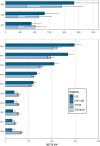Closing the Organofluorine Mass Balance in Marine Mammals Using Suspect Screening and Machine Learning-Based Quantification
- PMID: 38270113
- PMCID: PMC10851419
- DOI: 10.1021/acs.est.3c07220
Closing the Organofluorine Mass Balance in Marine Mammals Using Suspect Screening and Machine Learning-Based Quantification
Abstract
High-resolution mass spectrometry (HRMS)-based suspect and nontarget screening has identified a growing number of novel per- and polyfluoroalkyl substances (PFASs) in the environment. However, without analytical standards, the fraction of overall PFAS exposure accounted for by these suspects remains ambiguous. Fortunately, recent developments in ionization efficiency (IE) prediction using machine learning offer the possibility to quantify suspects lacking analytical standards. In the present work, a gradient boosted tree-based model for predicting log IE in negative mode was trained and then validated using 33 PFAS standards. The root-mean-square errors were 0.79 (for the entire test set) and 0.29 (for the 7 PFASs in the test set) log IE units. Thereafter, the model was applied to samples of liver from pilot whales (n = 5; East Greenland) and white beaked dolphins (n = 5, West Greenland; n = 3, Sweden) which contained a significant fraction (up to 70%) of unidentified organofluorine and 35 unquantified suspect PFASs (confidence level 2-4). IE-based quantification reduced the fraction of unidentified extractable organofluorine to 0-27%, demonstrating the utility of the method for closing the fluorine mass balance in the absence of analytical standards.
Keywords: Combustion ion chromatography; cetaceans; dolphins; high resolution mass spectrometry; ionization efficiency-based quantification; suspect screening.
Conflict of interest statement
The authors declare no competing financial interest.
Figures



References
-
- OECD . Reconciling Terminology of the Universe of Per- and Polyfluoroalkyl Substances: Recommendations and Practical Guidance; OECD Series on Risk Management, Ed.; OECD Publishing: Paris, 2021; No. 61. https://www.oecd.org/chemicalsafety/portal-perfluorinated-chemicals/term... (accessed 2021–09–03).
-
- Fenton S. E.; Ducatman A.; Boobis A.; DeWitt J. C.; Lau C.; Ng C.; Smith J. S.; Roberts S. M. Per- and Polyfluoroalkyl Substance Toxicity and Human Health Review: Current State of Knowledge and Strategies for Informing Future Research. Environ. Toxicol. Chem. 2021, 40 (3), 606–630. 10.1002/etc.4890. - DOI - PMC - PubMed
-
- Evich M. G.; Davis M. J. B.; McCord J. P.; Acrey B.; Awkerman J. A.; Knappe D. R. U.; Lindstrom A. B.; Speth T. F.; Tebes-Stevens C.; Strynar M. J.; Wang Z.; Weber E. J.; Henderson W. M.; Washington J. W. Per- and Polyfluoroalkyl Substances in the Environment. Science (1979) 2022, 375 (6580), eabg9065. 10.1126/science.abg9065. - DOI - PMC - PubMed
MeSH terms
Substances
LinkOut - more resources
Full Text Sources

